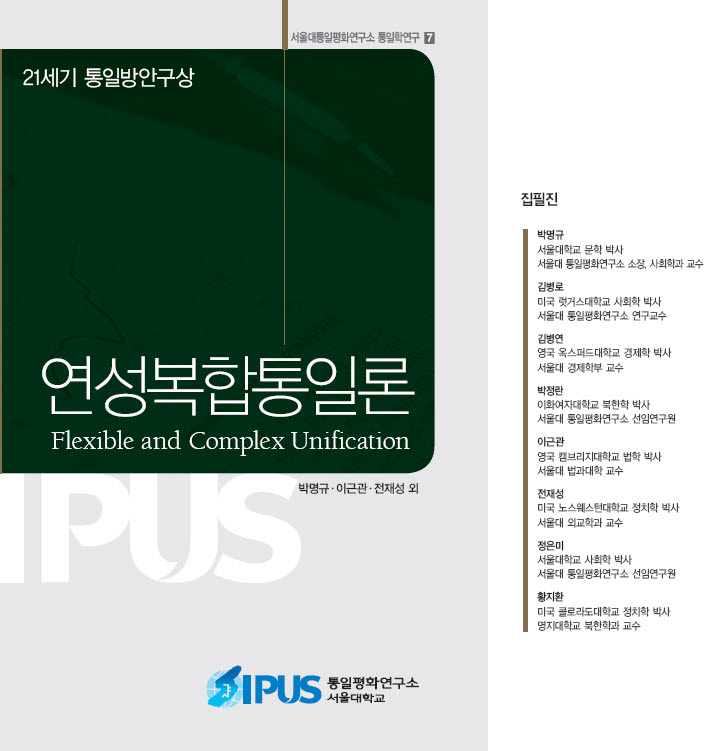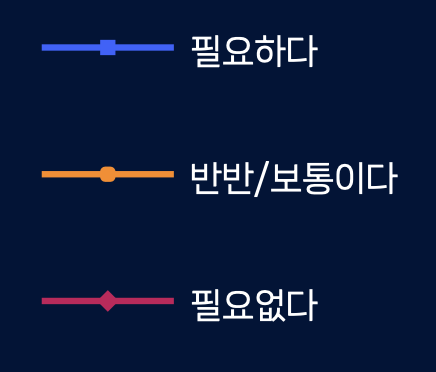Flexible and Complex Unification (in Korean)

Seoul National University Unification Studies Research Series – 7
Authors: Park Myeong-kyu, Kim Philo [Byeong-ro], Kim Byeong Yeon, Park Jeong Ran, Lee Keun-kwan, Jeon Jae-seong, Jeong Eun-mi, Hwang Ji-hwan
Contents
Introduction – Perceived Problems and Orientation of New Unification Theory
1. The Korean Peninsula in the 21st Century and the Expansion of Unification Theory
2. A Review of Environmental Changes and Existing Unification Measures
3. The Korean Peninsula in the 21st Century: Advancement, De-Division, and Unification
4. The Structure Comprising Flexible and Complex Unification Theory
Part I – Theory and Controversial Issues
Chapter 1 – Flexible and Complex Unification Theory and Strategy
1. New Unification Discourse
2. The Relationship Between North Korea Policy and Unification Policy
3. Flexible and Complex Unification Theory
4. Flexible and Complex Unification Strategy
Chapter 2 – Legal-Systemic Dimensions of Flexible and Complex Unification
1. Introduction
2. A Reexamination of Measures for National Unification and Ethnic Community From a Legal Perspective
3. An (International) Legal Examination of the Concept of ‘Unification’
4. Re-Understanding Territorial Clauses from a Flexible and Complex Unification Theoretical Perspective
5. Examining International Legal Problems on the Korean Peninsula from a Flexible and Complex Unification Theoretical Perspective
6. Conclusion
Chapter 3 – Unification Plans for the Ethnic Community: Significance and Tasks
1. The Content and Significance of Ethnic Community Unification Plans
2. A Reexamination of Ethnic Community Unification Plans
3. Ethnic Community Unification Plans and Concrete Controversial Issues
Part 2 – Domestic Environmental Changes and Flexible and Complex Unification
Chapter 4 – Environmental Changes in the 21st Century
1. The Changing International Environment and Problems for Unification
2. Issues in Perceptions of Changes in the Surrounding Area of the Korean Peninsula
3. The Changes of the International Environment and the Korean Peninsula in the 21st Century
4. Changes in the Northeast Asian Order and the Korean Peninsula
5. The 21st Century International Environment and Flexible and Complex Unification
Chapter 5 – Prospects of Changes in North Korean Society
1. Changes in the Last 20 Years
2. Prospects of Changes by Sector
3. Prospects of overall Results/Synthesis
Chapter 6 – Changes and Unification Theory in South Korean Society
1. The Expansion of Civil Society
2. Social Pluralization
3. Diversification of Identity
4. Globalization and Flexible and Complex Unification
Part 3 – Flexible and Complex Unification Policy
Chapter 7 – The Political and Diplomatic Sector
1. Inter-Korean Political Relations
2. The Military Dimension of Policy Towards North Korea
3. Objectives of Short-Term Engagement Policy
4. Objectives of Medium-Term Engagement Policy
Chapter 8 – The Economic Sector
1. Flexible and Complex Unification and the North Korean Economic System
2. Implementation and Economic Integration Policy of the North Korean Economic System
3. The Current State of Flexible and Complex Unification
Chapter 9 – The Socio-Cultural Sector
1. New Paradigms of Flexible and Complex Unification and Socio-Cultural Integration
2. Community Values and Creation of the Inter-Korean Socio-Cultural Integration
3. Formation of Autonomous Civil Society and Civil Awareness in North Korea
4. Enhancement and Expansion of Quality of Life, and Socio-Cultural Assets in North and South Korea
5. Integrated Coordination and Institutional Reform for Flexible and Complex Unification
Conclusion – In the New Generation, Preparing for Flexible and Complex Unification
1. Reflection, Opening, and Reconstruction of Unification Theory
2. Policy Implications
Published: 2010.04.23


















